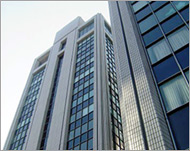Tokyo feels heat of overdevelopment
The hottest summer on record in Tokyois evidence that modern construction projects are playing havoc with local weather patterns.

This summer has been the hottest in the Japanese capital since records began, with temperatures above 30?C in central Tokyo surpassing the 37-day record set in 1995 in July.
On 20 July, a thermometer in the capital’s Adachi Ward recorded a scorching 42.7?C, breaking a record set in 1933 by nearly three degrees.
On 22 July, 48 people were hospitalised in Tokyo with heat stroke, while the following day a boy aged nine collapsed while playing softball and died later at a hospital.
Environmentalists are demanding that the government keep open “wind paths” along key routes from the coast to cool urban areas.
Problems galore
“The situation in the metropolitan district is very serious this summer,” said Koichiro Ishii of the Tokyo Metropolitan Government’s Research Institute for Environmental Protection.
“This is brought about by waste heat being released from vehicle exhausts and buildings’ airconditioning systems, along with a decrease in the amount of green space in the capital.”
 |
|
More heat sources are coming up |
As if these relatively old problems were not enough, a new heat source has been thrown up in the shape of the redevelopment of the Shinagawa and Shiodome districts of the city, right alongside Tokyo Bay.
“This ‘wall’ has definitely influenced the amount of wind that comes off Tokyo Bay and into the city,” Ishii said. “We are very interested in the impact of the redevelopment areas, but as they are new we do not have enough monitoring data to clearly explain their full effects.”
Environmentalists are calling for boulevards leading from the bay to be widened when old buildings are knocked down – or at least protected in their present state.
But the metropolitan government merely says it is currently studying the situation at the Shiodome site, which covers 30 hectares to the south of the city and has 13 buildings above 100 metres high.
Breezes disturbed
“We do not believe this will have an effect on future construction projects and the metropolitan government is not thinking about measures to limit redevelopment schemes,” Jun Ishikawa, a spokesman for the city, said.
“We are planning some steps to reduce the summer heat but it is too early to say what they will be.”
But Masazaku Moriyama, a professor at Kobe University’s
department of architecture and civil engineering, disagrees. He told The Japan Times newspaper that the metropolis needs more open spaces with broader streets to act as wind paths that allow sea breezes to circulate freely throughout the city and reduce temperatures.
“The situation in the metropolitan district is … brought about by waste heat being released from vehicle exhausts and buildings’ airconditioning systems, along with Koichiro Ishii of the Tokyo Metropolitan Government’s Research Institute for Environmental Protection |
While in recent days the effects of a strong typhoon have brought relief with rain and cooler temperatures, power companies reported record electricity usage in July and beer companies are delighted that the heat wave has forced sales up by 15%.
Citing a new report by Toshio Ojima, professor at Tokyo‘s Waseda University, an Environment Ministry official confirmed that recent construction work at Shiodome has “disturbed” cooling sea breezes and contributed to higher temperatures in the city.
“The area that has been redeveloped used to be railway yards until it was sold off ten years ago,” said Akinori Ogawa, a spokesman for the ministry.
“What used to be a large open space are now skyscrapers. Along with the Ministry of Land, Infrastructure and Transport, we are very concerned about the ‘heat island’ phenomenon and we are doing what we can to reduce it.”
‘Heat islands’ are the result of high concentrations of people.
Local problem
Now companies are being encouraged – with tax breaks – to plant gardens on the tops of their buildings to reduce the amount of heat that would simply be bounced off a concrete roof or glass windows, he said.
 |
|
Some studies show the effects of |
And while some scientists warn that further construction alongside the bay should be halted and that regulations need to be imposed to create broader streets to act as wind paths, others say the studies that have just begun will show that the effects of large-scale projects are minimal.
“I believe that it will just be a local problem close to these sites that have been built,” said Fumiaki Fujibe, a researcher with the government’s Meterological Research Institute.
“I think the effect of a few buildings will be very limited in comparison with the effect on the whole Tokyo metropolitan area, although if there was a line of tall buildings along the shore that would have more of an impact.”